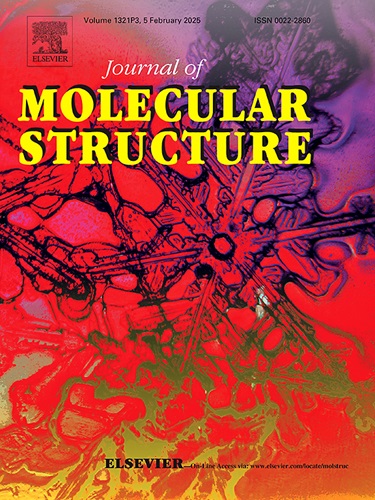Synthesis, crystal structures, DFT calculations, and oxygen radical absorbance capacity of 5-arylidene-thiazolidine-2,4‑dione derivatives
IF 4.7
2区 化学
Q2 CHEMISTRY, PHYSICAL
引用次数: 0
Abstract
A new green methodology has been developed for the synthesis of a series of substituted 5-arylidene-2,4-thiazolidinediones (ATZDs) 3a-q through Knoevenagel condensation, using barium hydroxide as an efficient heterogeneous catalyst. All compounds were characterized by ¹H NMR, ¹³C NMR, and HRMS spectroscopy. Additionally, seven compounds were analyzed by X-ray diffraction (XRD). Furthermore, some selected TZD derivatives were screened for their antioxidant activity using oxygen radical absorbance capacity (ORAC) assays. The results showed that five compounds exhibited excellent antioxidant properties, with ORAC values ranging from 4.73 TE to 6.31 TE, surpassing the reference antioxidants ferulic acid (3.70 TE) and melatonin (2.45 TE). Computational investigations based on the DFT method revealed that these compounds exert their antioxidant activity primarily through the HAT mechanism, preferentially from the OH bond rather than the NH bond. This study highlights the advantages of this methodology, providing products of high purity, with good yields and short reaction times, and proposes 5-arylidene-thiazolidine-2,4‑dione derivatives as promising antioxidants.
5- 芳基噻唑烷-2,4-二酮衍生物的合成、晶体结构、DFT 计算和氧自由基吸收能力
以氢氧化钡为高效异相催化剂,通过克诺文纳格尔缩合法合成了一系列取代的 5-芳基-2,4-噻唑烷二酮(ATZDs)3a-q。所有化合物都通过 ¹H NMR、¹³C NMR 和 HRMS 光谱进行了表征。此外,还通过 X 射线衍射 (XRD) 分析了七种化合物。此外,研究人员还利用氧自由基吸收能力(ORAC)测定法筛选了一些选定的 TZD 衍生物的抗氧化活性。结果表明,五种化合物表现出优异的抗氧化性,其 ORAC 值从 4.73 TE 到 6.31 TE 不等,超过了参考抗氧化剂阿魏酸(3.70 TE)和褪黑素(2.45 TE)。基于 DFT 方法的计算研究表明,这些化合物主要通过 HAT 机理发挥抗氧化活性,而且更倾向于通过 OH 键而不是 NH 键发挥抗氧化活性。这项研究凸显了这种方法的优势,它能提供纯度高、产率高和反应时间短的产品,并提出 5-芳基噻唑烷-2,4-二酮衍生物是一种很有前景的抗氧化剂。
本文章由计算机程序翻译,如有差异,请以英文原文为准。
求助全文
约1分钟内获得全文
求助全文
来源期刊

Journal of Molecular Structure
化学-物理化学
CiteScore
7.10
自引率
15.80%
发文量
2384
审稿时长
45 days
期刊介绍:
The Journal of Molecular Structure is dedicated to the publication of full-length articles and review papers, providing important new structural information on all types of chemical species including:
• Stable and unstable molecules in all types of environments (vapour, molecular beam, liquid, solution, liquid crystal, solid state, matrix-isolated, surface-absorbed etc.)
• Chemical intermediates
• Molecules in excited states
• Biological molecules
• Polymers.
The methods used may include any combination of spectroscopic and non-spectroscopic techniques, for example:
• Infrared spectroscopy (mid, far, near)
• Raman spectroscopy and non-linear Raman methods (CARS, etc.)
• Electronic absorption spectroscopy
• Optical rotatory dispersion and circular dichroism
• Fluorescence and phosphorescence techniques
• Electron spectroscopies (PES, XPS), EXAFS, etc.
• Microwave spectroscopy
• Electron diffraction
• NMR and ESR spectroscopies
• Mössbauer spectroscopy
• X-ray crystallography
• Charge Density Analyses
• Computational Studies (supplementing experimental methods)
We encourage publications combining theoretical and experimental approaches. The structural insights gained by the studies should be correlated with the properties, activity and/ or reactivity of the molecule under investigation and the relevance of this molecule and its implications should be discussed.
 求助内容:
求助内容: 应助结果提醒方式:
应助结果提醒方式:


